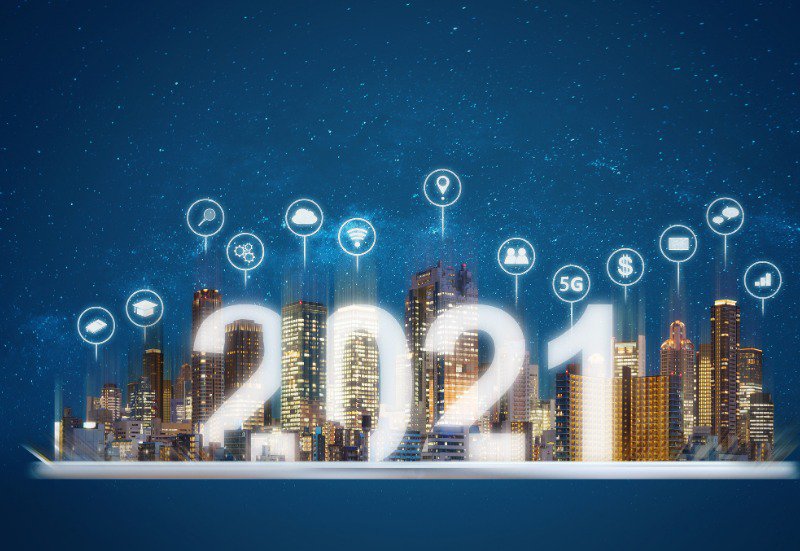Last year was a tough and unprecedented one for many businesses. As they looked to stay afloat amid a heavily restricted world, they increasingly turned to technology for aid. Though vaccines are rolling out and cases are going down in many parts of the world, there’s a good chance 2021 will continue these technology trends.
As companies look to maintain caution and protect their employees, we’ll undoubtedly see an increase in software and hardware that benefits a remote workforce. However, 2021 is also the year when technologies without direct relation to the pandemic are expected to reach mass adoption. Despite the disruption of lockdowns, progress has continued in connectivity, cybersecurity, and beyond. Let’s take a look at some of the major business technology trends the year is primed to deliver:
Biggest Technology Trends: A More Connected World
Though the ability to engage in physical contact will remain limited in 2021, it’s set to be the most internet-connected year on record. 5G has been rolling out since 2019, but experts say this year will be an inflection point in its readiness and availability.
With up to 100 times faster speeds than 4G networks, 5G is bound to have an impact on many businesses. This is especially true due to its lower latency and higher bandwidth. This technology trend will allow companies to enhance edge computing and deliver experiences to consumers they wouldn’t previously be able to.
In parts of the world where high-speed cellular isn’t possible, initiatives like SpaceX’s Starlink will deliver low-latency, high-speed satellite internet. This will enable a new wave of internet-connected businesses in rural and developing areas.
The Internet of Behaviors
5G will also help to build on a much more recent trend, one that experts are calling the Internet of Behaviors (IoB). According to Gartner, the pandemic has created a world where exhaustive data collection is more commonplace. Tools like RFID tags, computer vision, and deep analytics are being utilized to ensure employees obey Covid-19 protocols and inform Human Resources systems.
The collection and use of such data is known as the Internet of Behaviors. It’s likely to have implications far beyond the pandemic. Recent developments let businesses collect, combine, and analyze data from numerous sources and use it to affect human behavior and habits. The technology that drives this will only become more sophisticated with time, enabling new use cases that may clash with some privacy legislation.
Unprecedented Automation
While many businesses have been utilizing automation for some time, the workforce and productivity shortages caused by Covid-19 have significantly increased its reach. Technology trends like hyper-automation – automating every process in the business that can be automated – can provide significant competitive advantages.
Machine learning is being used more liberally in the background to handle logic trees, while automation tools allow the technology stack to be more unified even if solutions aren’t fully integrated. Critically, the cost of such automation has fallen enough to be feasible for small businesses, which can combine it with their natural agility to great effect. Larger shipping and delivery industries, too, are benefiting from automation. Contactless delivery will become the new normal in 2021, with the US already seeing a 20% increase in consumer preference for contactless operations. As well as introducing tools to safely deliver food to the doorstep rather than the customer, large companies are deploying or testing robotic deliveries. Autonomous driving, too, is likely to play a role in the coming year, though legislative progress is likely to be slow in many countries.
Anywhere Operations
The ability to access a business’ services from anywhere has proven vital during the pandemic. Following significant investment in mobile apps, delivery infrastructure, and more, it’s unlikely this model is going anywhere.
A digital-first mindset will become more common across a wide range of industries, from financial services to retailers and medical providers. Currently, this mindset is being adopted to reduce physical contact, but in the future, it will also help to lower reliance on physical workers and provide convenient customer experiences.
Augmented and Virtual Reality
The use case for augmented and virtual reality in business has always been there, but companies haven’t had enough motivation to invest on a mass scale. With the release of Microsoft’s HoloLens 2 and other, more affordable headsets, that has begun to shift.
Tying 2 technology trends together, the idea of anywhere operations, augmented and virtual reality can address many challenges that have arisen due to the pandemic – from AR collaboration spaces to shared virtual shopping experiences. According to CommerceNext, the increase in VR/AR investments in retail increased by 21% in June 2020, versus 8% that same January. Thanks to years of smartphone hardware improvements, the furnishing and beauty industries especially have been able to help customers preview purchases from the confines of their own homes.
Though augmented and virtual reality still face plenty of obstacles when it comes to mass adoption, their growth is likely to be accelerated by emerging technologies like 5G. Virtual sporting events, eye tracking, facial expression recognition, AR avatars, and more are all likely to see increased growth in 2021.
Technology Trends: Honorable Mentions
These are just some of the key areas businesses can expect to see evolution in the coming year. Undoubtedly, 2021 will see some surprises, but some longer-term trends are expected to continue, too.
- Cybersecurity will remain an area of development and investment, especially when it comes to an identity-based cybersecurity mesh approach.
- Distributed cloud will also see growth, helping organizations reduce latency by placing cloud services in different physical cloud locations, yet leaving the complexity of control in the hands of the provider.
- Though legislation like GDPR and CCPA are now in the rear-view mirror, privacy will continue to be a hot topic. We’re likely to see an increase in computation that protects data at all stages of the process.
Last, but not least, unified communication and remote collaboration tools will continue to dominate the conversation, though perhaps not as explosively as before. Microsoft Teams in particular is poised for further market penetration as companies make use of affordable Microsoft 365 subscriptions to turn it into a fully-fledged productivity hub.
Need help implementing some of 2021’s trends in your business? Schedule a risk-free IT assessment today to see how VirtuWorks can help.


